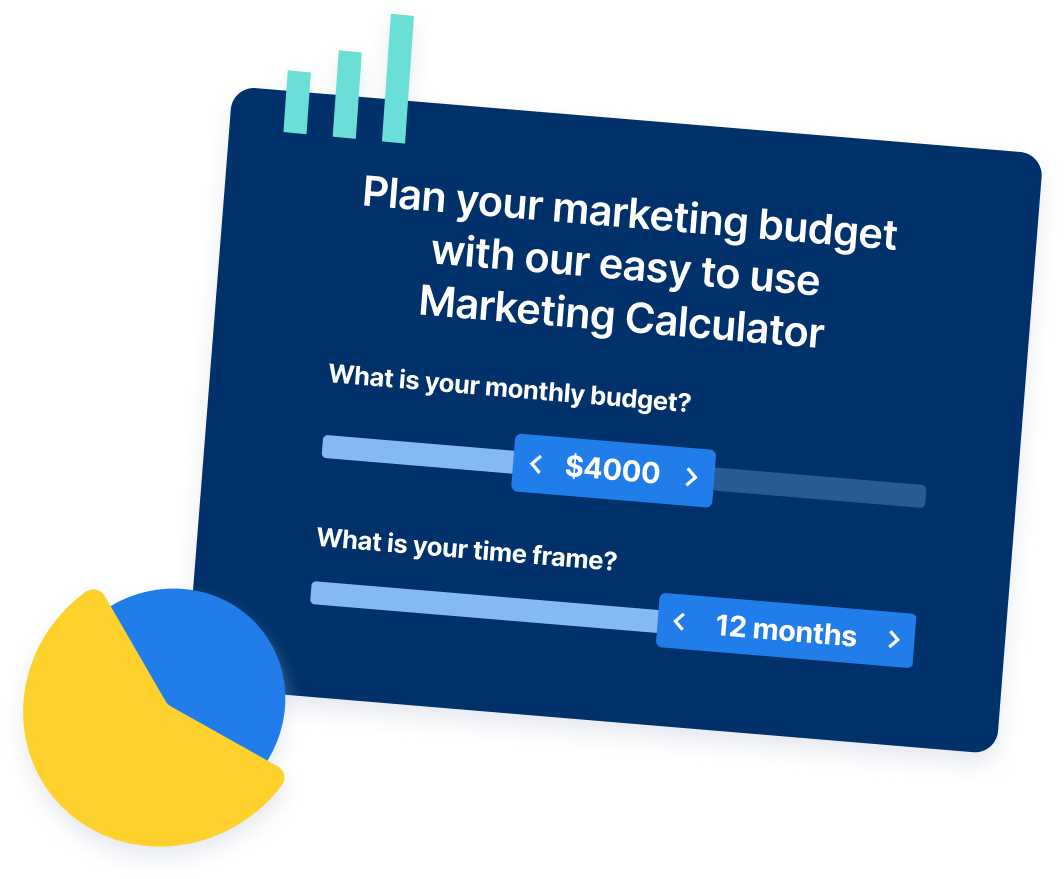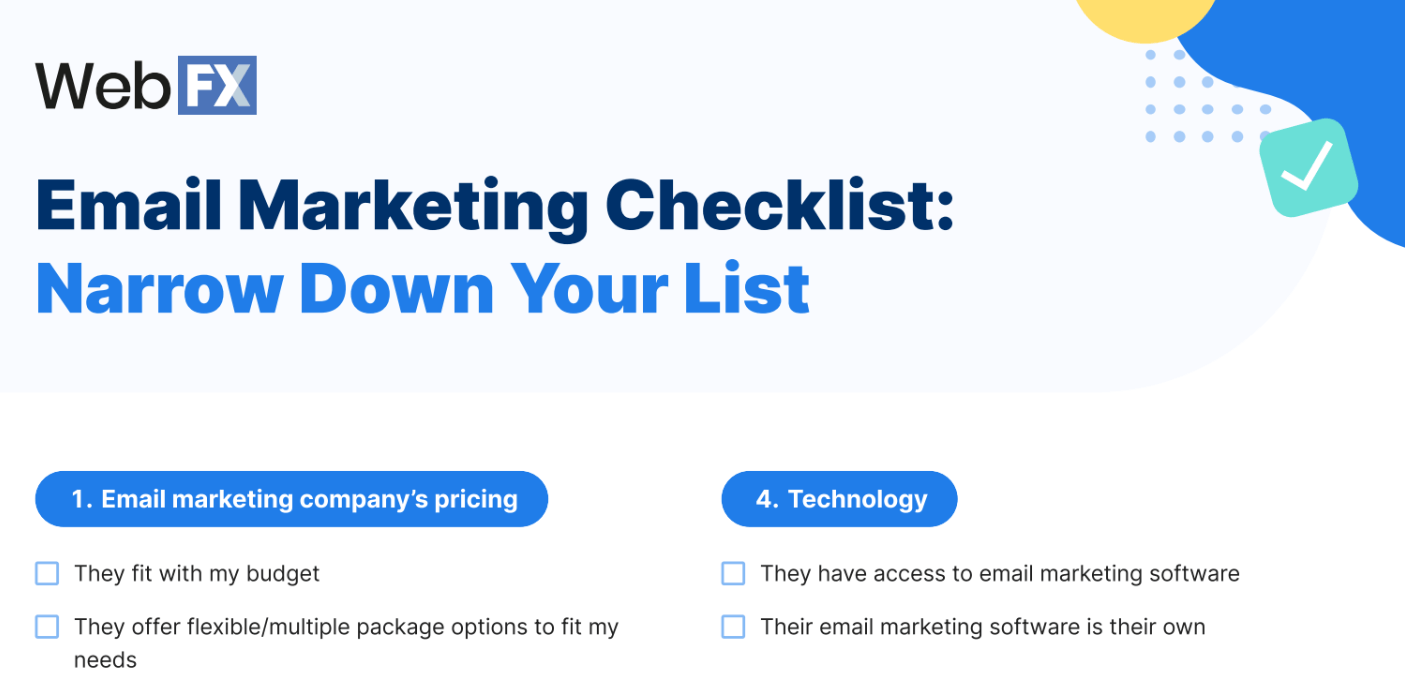-
 Published: Apr 4, 2025
Published: Apr 4, 2025
-
 10 min. read
10 min. read
-
 Emily Carter, M.S.
Emily Carter, M.S. Sr. Content Team Lead
Sr. Content Team Lead
- Emily leads the FX content team, along with strategy, implementation, and evaluation for WebFX’s key revenue channels. She holds an M.S. in digital marketing, and her work has been featured by Social Media Today, Campaign Monitor, Reader’s Digest, and more. In her free time, she enjoys hiking, road trips, and exploring new cities. @emcarter16
Email marketing is one of the highest ROI channels out there — generating an average of $36 for every $1 spent. But building a strategy that actually performs takes time, tools, and expertise.
If you’re like many growing businesses, email falls off the radar or gets rushed out with little impact. You know it matters, but finding the time or in-house skill to do it right isn’t easy.
That’s where outsourcing comes in. The right partner brings strategy, content, design, and automation — without the overhead of building it all yourself.
In this guide, we’ll show you when to outsource email marketing, how to choose the right provider, and answer some of the top FAQs about outsourcing email.
Download Now: Email Marketing Checklist for Outsourcing Email
5 benefits of outsourcing email marketing
- Lower overhead than hiring in-house: Outsourcing eliminates the need to hire, train, and manage a full-time email team. You get access to experienced strategists, designers, and copywriters — without the ongoing salary, benefits, and management costs.
- Save money on tools and technology: Agencies often have access to premium email platforms, testing tools, and automation software (tools that could cost you hundreds or thousands per month if purchased separately). You get the benefits without the extra subscription fees.
- Faster results, less trial-and-error: A seasoned agency brings proven strategies, templates, and A/B testing frameworks to the table, helping you skip the guesswork and start seeing ROI sooner.
- Stronger campaign performance through ongoing optimization: Agencies analyze your audience, segment your lists, and continuously optimize subject lines, send times, and CTAs — leading to higher open rates, more clicks, and better conversions.
- Scalable support as you grow: As your business and list size expand, an agency can scale your email efforts without you having to build additional internal resources. That means you can increase frequency, complexity, and personalization — all without slowing down.
When to outsource email marketing: Key decision points
Not sure if outsourcing is the right move? Use the table below to weigh your options based on your team’s resources, goals, and current performance.
| Decision Point | Outsource Email If: | Keep Email In-House If: |
| Internal Expertise | You lack experienced email strategists, copywriters, or designers. | You have a skilled in-house team that consistently delivers results. |
| Time & Bandwidth | Your team is stretched thin and can’t prioritize email marketing. | You have dedicated team members with capacity to manage campaigns. |
| Campaign Performance | Open rates, click-throughs, or conversions are underperforming. | Your current strategy is meeting or exceeding performance goals. |
| Tool & Tech Costs | You’re paying for multiple tools or not using advanced features effectively. | You already have tech stack dialed in and are seeing strong ROI. |
| List Growth & Segmentation | Your list isn’t growing, or you’re not segmenting for targeted sends. | You have clear audience segments and an active, engaged list. |
| Need for Consistency | Campaigns go out sporadically or get delayed due to other priorities. | You consistently send timely, well-executed campaigns. |
| Scalability & Growth | You want to ramp up frequency, personalization, or automation — fast. | Your current process can scale without losing quality or momentum. |
| Budget Allocation | You can invest in expert services for long-term ROI. | You’re on a tight budget and can maintain results internally. |
How to outsource email marketing
Choosing the right email marketing provider isn’t just about outsourcing work — it’s about finding a partner who can drive results without draining your budget.
Below are eight key steps to help you evaluate providers with confidence, from pricing and platforms to strategy and fit.
8 Steps for Outsourcing Email
- Get clear on your scope, budget, and email goals
- Decide what type of email provider you need
- Prioritize email providers that focus on bottom-line impact
- Choose an email provider that can seamlessly integrate with your tech stack
- Evaluate email pricing and deliverables
- Look for proof like case studies and testimonials
- Request your custom email proposal & ask for demos
- Finalize your selection and contract
1. Get clear on your scope, budget, and email goals
Before you compare providers, define what you actually need help with.
- Level of support needed: Decide whether you need full-service help (strategy, copy, design, automation) or just executional support like writing or scheduling.
- Primary email goals: Clarify your top priorities — whether it’s nurturing leads, increasing ecommerce sales, or re-engaging inactive subscribers.
- Email volume: Estimate how many emails you plan to send per month to ensure potential partners can handle the workload.
- Budget range: Set a realistic monthly or project-based budget so you can quickly rule out providers that are too costly (or too bare-bones).
- Internal resources: Consider what your team can realistically manage in-house vs. what needs to be handed off completely.
Getting clear on these points will help inform which providers are a good fit from the start.
2. Decide what type of email provider you need
When it comes to email management, there’s a spectrum of options: Freelance email specialists, marketing consultants, boutique agencies, and full-service digital firms.
Freelancers may be more affordable but lack strategic depth or scalability. Larger agencies bring more resources but can come with higher minimums or longer ramp-up times. Choose based on your complexity, internal capacity, and need for strategic guidance vs. tactical support.
Here are some key points to consider when deciding what type of email provider is best for you.
| Provider Type | Best For | Pros | Cons |
| Freelance Email Specialist | Small businesses or one-off projects with limited scope | Affordable, flexible, often skilled in one area (copy, design, or platform setup) | May lack strategic oversight, limited availability, can’t scale easily |
| Marketing Consultant | Businesses that need high-level strategy without full execution | Offers strategic insight, audits, and direction without committing to long-term execution | Doesn’t typically handle campaign production or ongoing management |
| Boutique Email Agency | Mid-size businesses wanting personalized service and full campaign support | Balanced pricing, hands-on support, creative and strategic services in one place | May have limited bandwidth for larger or rapidly scaling accounts |
| Full-Service Digital Agency | Companies looking to integrate email into a broader marketing strategy | Cross-channel expertise, deep resources, dedicated teams, scalability | Higher cost, longer onboarding, may not be ideal for email-only needs |
3. Prioritize email providers that focus on bottom-line impact
The right partner should go beyond design and delivery. They should build strategies that directly impact your bottom line.
Look for providers who can map email campaigns to key stages in your customer journey, create high-converting automations, and back their approach with real data. If they can’t speak clearly about how they’ll help you increase revenue, retention, or customer lifetime value, keep looking.
4. Choose an email provider that can seamlessly integrate with your tech stack
Your email strategy shouldn’t operate in a silo. It should work hand-in-hand with your CRM, ecommerce platform, and customer data.
Look for providers who understand how to connect email with your broader marketing stack and can integrate seamlessly with your CRM or custom tech stack.
The best partners will not only work within your systems, but help you unlock hidden value through smarter automations, deeper segmentation, and personalized campaigns powered by real-time data.
5. Evaluate email pricing and deliverables
Email marketing providers use different pricing structures — from per-campaign rates to monthly retainers or performance-based fees.
Don’t just compare price tags. Dig into what’s actually included: Strategy, A/B testing, list management, reporting, and design revisions can all vary.
Be cautious of vague scopes and low-cost offers that seem too good to be true. Quality email marketing that drives revenue is an investment, and cutting corners often costs more in the long run.
Here are a few key things to think about when it comes to email pricing.
| Pricing Model | Typical Cost Range | Best For |
| Per Campaign | $500 – $3,000+ per campaign | One-off campaigns, seasonal promos, small businesses |
| Monthly Retainer | $1,000 – $7,500+/month | Businesses needing consistent email execution and growth |
| Hourly | $50 – $200+/hour | Project-based support or occasional consulting |
| Performance-Based | Commission or % of revenue (5–20%) | Ecommerce or high-volume businesses focused on ROI |
| Project-Based (One-Time) | $1,500 – $10,000+ | Redesigns, audits, or setup work without ongoing commitment |
| Freelancer (Per Email) | $100 – $500/email | Budget-conscious teams needing occasional sends |
6. Look for proof like case studies and testimonials
Anyone can promise results — the best agencies prove them. Dig into case studies that show how they’ve improved open rates, driven revenue, or helped clients scale. Look for specifics: What were the goals? What actions did the agency take? What measurable outcomes did they deliver?
Also, scan reviews and testimonials for red flags like poor communication or missed deadlines. Bonus points if you can speak directly to a past or current client. A credible provider should be proud to share success stories that align with your goals.
7. Request your custom email proposal & ask for demos
Once you’ve narrowed down your shortlist, ask each provider for a tailored proposal, not just a generic service list.
A strong proposal should clearly outline:
- How they’ll approach your business goals
- What deliverables are included (and how often)
- Pricing structure
- Timelines
- ROI reporting
This is your chance to see how well they understand your business and whether they’re bringing fresh, strategic ideas to the table.
If the provider uses proprietary tools or custom dashboards, ask for a demo. Whether it’s reporting software, list segmentation tools, or automation frameworks, you want to know what tech you’ll have access to and how it fits into your current workflow.
The best agencies won’t just pitch their services. They’ll show you exactly how their systems and solutions can make your life easier and your email campaigns more effective.
8. Finalize your selection and contract
Once you’ve compared proposals, seen a demo (if applicable), and asked your key questions, it’s time to make your pick.
Choose the provider that not only fits your budget and goals, but also feels like a collaborative, proactive partner, not just a vendor. Look for signs they understand your business, offer strategic value, and have a clear plan to drive measurable results.
Before signing, review the contract closely. Make sure deliverables, timelines, communication expectations, and exit terms are clearly defined. Clarify how revisions, reporting, and scope changes will be handled. A well-structured agreement protects both sides and sets the tone for a successful, long-term partnership.
🚩 Email agency red flags
Even the most polished pitch can hide signs of a poor fit. Watch for these common red flags that signal an email marketing agency or provider might not deliver the results you’re looking for:
- Generic strategy: If they can’t clearly explain how they’ll tailor your email campaigns to your business goals, you’re likely getting a one-size-fits-all approach.
- No track record of revenue impact: Providers that focus only on vanity metrics (like open rates) without tying their work to conversions or ROI should raise concern.
- Limited platform knowledge: If they fumble through questions about your email platform or CRM, they may not be equipped to fully leverage your tech stack.
- Slow or surface-level communication: Delayed responses or overly high-level answers during the vetting process often lead to frustrating collaboration later on.
- Lack of reporting transparency: If they can’t show you past results or provide a sample report, it’s a sign they may not prioritize data or accountability.
Email Marketing Outsourcing FAQs: When, why, and how to get the help you need
How much does it cost to outsource email marketing?
The cost varies depending on the scope and complexity of services. On average, businesses might spend around $1,500-$2,500 per month when working with an agency that charges between $100 – $200 per hour.
What are the benefits of outsourcing email marketing?
Outsourcing can be cost-effective, save time, provide access to professional expertise, offer cutting-edge marketing technology, and deliver scalable strategies.
How do I choose the right email marketing agency?
Evaluate an agency’s services, analyze their portfolio, compare pricing models, consider their email marketing software expertise, and ask relevant questions to ensure they align with your business goals.
Can outsourcing email marketing improve ROI?
Yes, by leveraging the expertise of specialized agencies, businesses can craft more effective campaigns, leading to better engagement and increased revenue.
Is it better to outsource or keep email marketing in-house?
Outsourcing provides access to specialized skills and can be more cost-effective, especially for small businesses without dedicated marketing teams. However, keeping it in-house offers more control over campaigns. The decision depends on your company’s resources and marketing objectives.
Outsource email marketing with confidence — powered by strategy and software
When it comes to choosing an email marketing partner, you need more than just a service provider — you need a team that’s invested in your growth.
At WebFX, we combine award-winning strategy with powerful in-house tech like EmailMarketingFX, our proprietary email platform built to boost engagement, automate smarter, and drive real ROI. As a top U.S. email marketing agency, we’ve helped clients get a 14% average life in sales from email — and we’d love to help you do the same.
Ready to turn your email list into a revenue-driving machine? Check out our email services and contact us online to speak with a strategist and see what’s possible with WebFX.
-
 Emily leads the FX content team, along with strategy, implementation, and evaluation for WebFX’s key revenue channels. She holds an M.S. in digital marketing, and her work has been featured by Social Media Today, Campaign Monitor, Reader’s Digest, and more. In her free time, she enjoys hiking, road trips, and exploring new cities.@emcarter16
Emily leads the FX content team, along with strategy, implementation, and evaluation for WebFX’s key revenue channels. She holds an M.S. in digital marketing, and her work has been featured by Social Media Today, Campaign Monitor, Reader’s Digest, and more. In her free time, she enjoys hiking, road trips, and exploring new cities.@emcarter16 -

WebFX is a full-service marketing agency with 1,100+ client reviews and a 4.9-star rating on Clutch! Find out how our expert team and revenue-accelerating tech can drive results for you! Learn more
Try our free Marketing Calculator
Craft a tailored online marketing strategy! Utilize our free Internet marketing calculator for a custom plan based on your location, reach, timeframe, and budget.
Plan Your Marketing Budget
Table of Contents
- 5 Benefits of Outsourcing Email Marketing
- When to Outsource Email Marketing: Key Decision Points
- How to Outsource Email Marketing
- 1. Get Clear on Your Scope, Budget, and Email Goals
- 2. Decide What Type of Email Provider You Need
- 3. Prioritize Email Providers That Focus on Bottom-line Impact
- 4. Choose an Email Provider That Can Seamlessly Integrate with Your Tech Stack
- 5. Evaluate Email Pricing and Deliverables
- 6. Look for Proof Like Case Studies and Testimonials
- 7. Request Your Custom Email Proposal & Ask for Demos
- 8. Finalize Your Selection and Contract
- 🚩 Email Agency Red Flags
- Email Marketing Outsourcing FAQs: When, Why, and How to Get the Help You Need
- Outsource Email Marketing with Confidence — Powered by Strategy and Software

Proven Marketing Strategies

Proven Marketing Strategies
Try our free Marketing Calculator
Craft a tailored online marketing strategy! Utilize our free Internet marketing calculator for a custom plan based on your location, reach, timeframe, and budget.
Plan Your Marketing Budget






